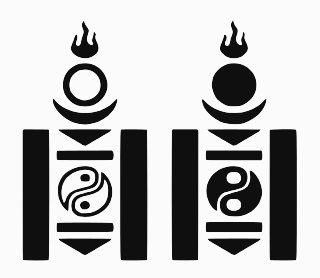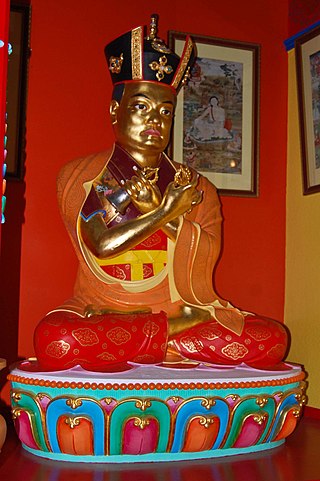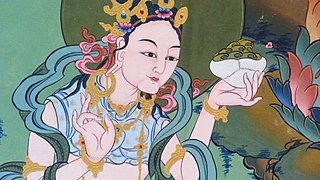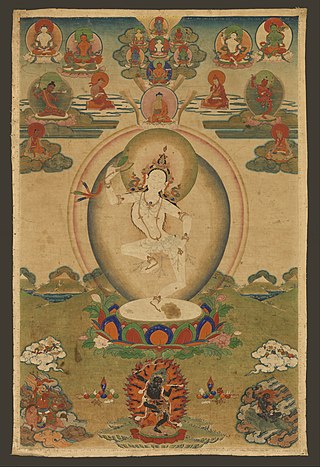
The Soyombo script is an abugida developed by the monk and scholar Zanabazar in 1686 to write Mongolian. It can also be used to write Tibetan and Sanskrit.
The 10th Dalai Lama, Tsultrim Gyatso (full given name Ngawang Lobzang Jampel Tsultrim Gyatso or Tsultrim Gyatso was the 10th Dalai Lama of Tibet, and born in Litang, Kham. He was fully ordained in the Gelug school of Tibetan Buddhism, studied the sutras and tantras, had several students, and rebuilt the Potala Palace.

The music of Tibet reflects the cultural heritage of the trans-Himalayan region centered in Tibet, but also known wherever ethnic Tibetan groups are found in Nepal, Bhutan, India and further abroad. The religious music of Tibet reflects the profound influence of Tibetan Buddhism on the culture.

Karma Kagyu, or Kamtsang Kagyu, is a widely practiced and probably the second-largest lineage within the Kagyu school, one of the four major schools of Tibetan Buddhism. The lineage has long-standing monasteries in Tibet, China, Russia, Mongolia, India, Nepal and Bhutan, with current centres in over 60 countries. The spiritual head of the Karma Kagyu is the Gyalwa Karmapa; the 2nd among the 10 Karmapas had been the principal spiritual advisors to successive emperors of China. The Karma Kagyu are sometimes called the "Black Hat" lamas, in reference to the Black Crown worn by the Karmapa.

Yeshe Tsogyal, also known as "Victorious Ocean of Knowledge", "Knowledge Lake Empress", or by her Sanskrit name Jñānasāgarā "Knowledge Ocean", or by her clan name "Lady Kharchen", attained enlightenment in her lifetime and is considered the Mother of Tibetan Buddhism. Yeshe Tsogyal is the highest woman in the Nyingma Vajrayana lineage. Some sources say she, as Princess of Karchen, was either a wife or consort of Tri Songdetsen, emperor of Tibet, when she began studying Buddhism with Padmasambhava, who became her main karmamudrā consort. Padmasambhava is a founder-figure of the Nyingma tradition of Tibetan Buddhism, and is considered as a second buddha of our era. She is known to have revealed terma with Padmasambhava and was also the main scribe for these terma. Later, Yeshe Tsogyal also hid many of Padmasambhava's terma on her own, under the instructions of Padmasambhava for future generations.
Sylvia Wetzel is a Buddhist feminist, with a focus on the Buddhist community of Germany in the topics of meditation and spirituality among women.

Khenpo Tsültrim Gyamtso Rinpoche was a Tibetan scholar yogi in the Kagyu tradition of Tibetan Buddhism. He taught widely in the West, often through songs of realization, his own as well as those composed by Milarepa and other masters of the past. "Tsültrim Gyamtso" translates to English as "Ocean of Ethical Conduct". He died on 22 June 2024, at the age of 90.

A kartika or drigug is a small, crescent-shaped, hand-held ritual flaying knife used in the tantric ceremonies of Vajrayana Buddhism. The kartari is said to be "one of the quintessential attributes of the wrathful Tantric deities." It is commonly known as the "knife of the dakinis." Its shape is similar to the Inuit ulu or woman's knife, which is used for many things including cleaning skins.
Dark retreat is a spiritual retreat in a space that is completely absent of light, which is an advanced practice of Tibetan Buddhism and Bön.

Machig Labdrön, or "Singular Mother Torch from Lab" (1055–1149), was a female Tibetan Buddhist monk believed to be a reincarnation of Yeshe Tsogyal, and the renowned 11th-century Tibetan tantric Buddhist master and yogini that originated several Tibetan lineages of the Vajrayana practice of Chöd.
Chöd is a spiritual practice found primarily in the Yundrung Bön tradition as well as in the Nyingma and Kagyu schools of Tibetan Buddhism. Also known as "cutting through the ego," the practices are based on the Prajñāpāramitā or "Perfection of Wisdom" sutras, which expound the "emptiness" concept of Buddhist philosophy.

Swayambhu Mahachaitya is an ancient religious complex atop a hill in the Kathmandu Valley, west of Kathmandu city. The Tibetan name for the site means 'Sublime Trees', for the many varieties of trees found on the hill. However, Shingun may be of in Nepal Bhasa name for the complex, Swayambhu, meaning 'self-sprung'. For the Buddhist Newars, in whose mythological history and origin myth as well as day-to-day religious practice Swayambhu occupies a central position, it is the most sacred among Buddhist pilgrimage sites. For Tibetans and followers of Tibetan Buddhism, it is second only to Boudha. Swayambhu is the Hindu name.
A namtar, sometimes spelled namthar, is a spiritual biography or hagiography in Tibetan Buddhism.

The gyaling, literally "Indian trumpet", is a traditional woodwind instrument used in Tibet. As its name indicates, it is the Chinese double reed Suona horn used mainly in Tibetan monasteries during puja and is associated with peaceful deities and the idea of devotion.
In Dzogchen, rainbow body (Tibetan: འཇའ་ལུས་, Wylie: 'ja' lus, Jalü or Jalus) is a level of realization. This may or may not be accompanied by the 'rainbow body phenomenon'. The rainbow body phenomenon is pre-Buddhist in origin and is related to the indigenous Tibetan Bon religion, and is a topic which has been treated fairly seriously in Tibet for centuries past and into the modern era. Other Vajrayana teachings also mention rainbow body phenomena which occur during or after the dying process.
State Religious Affairs Bureau Order No. 5, officially named Measures on the Management of the Reincarnation of Living Buddhas in Tibetan Buddhism, is an order passed during a conference of the State Administration for Religious Affairs on 13 July 2007, marked for implementation on 1 September 2007.
Lama Tsultrim Allione is an American author and teacher who has studied in Tibetan Buddhism's Karma Kagyu lineage. She has been recognised by two different Tibetan Buddhist lamas as an emanation of Machig Labdron, the 11th/12th century CE female founder of several chöd lineages.
The Sanskrit term adhiṣṭhāna is the name for blessings or inspiration that a Buddhist may receive from a Buddha, bodhisattva or guru. The Sanskrit term has various meanings in Mahayana and Vajrayana Buddhism, and can also mean the raised base on which a temple stands.
Shukseb Jetsunma Chönyi Zangmo (1865–1953) was the most well known of the yoginis in the 1900s, and was considered an incarnation of Machig Lapdron. She was the abbess of Shukseb nunnery, and was a Nyingma Tibetan Buddhist teacher. She made the nunnery once again into a center for the special teachings of the Shugseb Kagyu. The nunnery still exists in Tibet today, and in fact is one of its most active nunneries.
Praise to Tara in Twenty One Verses is a traditional prayer in Tibetan Buddhism to the female Bodhisattva Tara also known as Ārya Tārā, or Jetsun Dolma. The text is originally a Sanskrit Indian Buddhist work, and it is the most popular prayer to Tara in Tibetan Buddhism.










